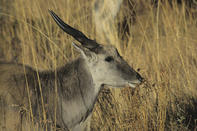Grazers and Browsers
Eland are the largest antelope in the Lowveld and indeed in Southern Africa. This southern-occurring species is superseded in size only by their North-West African relatives, the giant or Lord Derby’s eland as the largest antelope in the world.

Eland are adapted to living independently of water supplies. They do not have to drink regularly (although they do where water is readily available) but rather get the moisture they need from the food they eat or from other simple water conservation techniques.
Eland feed during the day but they also feed at night when the moisture content of foliage is higher. They produce very concentrated urine and dry faecal pellets so as not to discard of moisture unnecessarily. They will stand in the shade on very hot days and have the ability (like gemsbok) to allow their body temperature to rise by a few degrees dissipating the heat after dark when it’s cooler. Eland breathe deeply and slowly to conserve the moisture in their nasal passages.
Eland are ruminants (have 4-chambered stomachs) and as such, they need to be somewhat selective in what they eat to accommodate their fibre-sensitive systems. In summer when grass is the most nutritious source of food around, eland will eat mostly grass.
They are often found in newly burnt areas or where grass is newly shooting. In winter browse holds its nutrient and moisture contents more successfully than grass and eland switch to browse at this time of the year particularly favouring protein-rich species like mopane and even eating the dried leaves of such trees for nutrients (see pg…).
They are adept at using their horns to twist-snap off branches of trees with foliage out of their reach. Once hanging down or broken off, other eland can then also feed off the stem (providing the animal in attendance is not more dominant!). When food is abundant eland tend to be more sedentary and less nomadic.
Meticulous Groomers

Members of a herd of eland allogroom (mutual grooming) one another on the head, neck and rump areas, all the places that are hard to reach themselves. They are also meticulous about grooming themselves and regularly rub their heads and bodies against trees and other objects at the right height.
Like the cattle they so closely resemble, eland are followed by cattle egrets which benefit from the insects kicked up by the antelope as the move and also remove parasites from the antelopes’ bodies.
By Megan Emmett